The old Commissioner's Palace
Until the middle of the 13th century, the area where today's Palazzo Nota would stand was occupied by a vegetable garden dotted with trees.
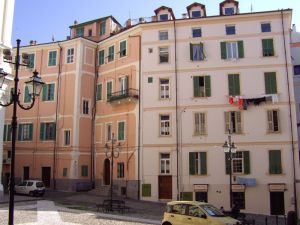 In this area, located next to the church of Santo Stefano, the archbishop of Genoa Gualtiero da Vezzano built the new archbishop's palace in 1258, which was then enlarged in 1282 by archbishop Bernardo de Arimindis of Parma.
In this area, located next to the church of Santo Stefano, the archbishop of Genoa Gualtiero da Vezzano built the new archbishop's palace in 1258, which was then enlarged in 1282 by archbishop Bernardo de Arimindis of Parma.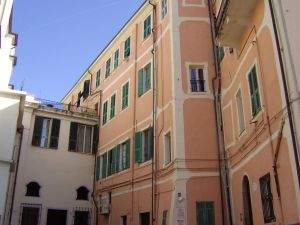 Severely damaged but not completely destroyed by fire towards the end of the 14th century, it was flanked on the western side during the same period or at the latest at the beginning of the 15th century by a new, equally grandiose building that became the town hall and the seat of the Podestà, the official sent from Genoa to govern the city.
Severely damaged but not completely destroyed by fire towards the end of the 14th century, it was flanked on the western side during the same period or at the latest at the beginning of the 15th century by a new, equally grandiose building that became the town hall and the seat of the Podestà, the official sent from Genoa to govern the city.
On 25 February 1396 the archbishop's palace had meanwhile passed into the hands of Percivalle Curlo, while on 11 August 1416 Percivalle's son Antonio Curlo gave it in emphyteusis to Andrea Rambaldo.
On 12 June 1478 the old building, formerly the seat of the archbishop's offices, was sold by the Revisors' Office of the Municipality of Genoa to the family of Bartolomeo Palmari.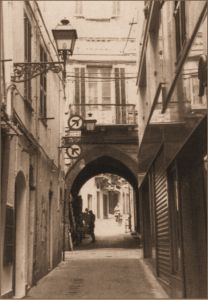
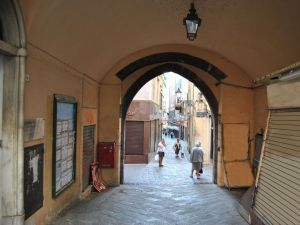 From the beginning of the 15th century, a long building already completely occupied the southern side of what is now Piazza Cassini, separating it from the Roman road below (today's Via Palazzo), up to the point where the latter joined the road leading from the sea to the Porta di Santo Stefano (Via Cavour).
From the beginning of the 15th century, a long building already completely occupied the southern side of what is now Piazza Cassini, separating it from the Roman road below (today's Via Palazzo), up to the point where the latter joined the road leading from the sea to the Porta di Santo Stefano (Via Cavour).
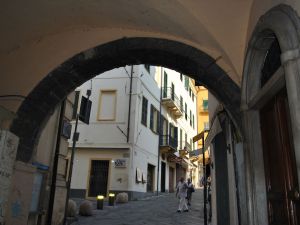 Exactly at the point where the two streets intersected (the crossroads known as 'Croce del Palazzo') a gate was built, the keeper of which was regularly paid by the Municipality in 1494.
Exactly at the point where the two streets intersected (the crossroads known as 'Croce del Palazzo') a gate was built, the keeper of which was regularly paid by the Municipality in 1494.
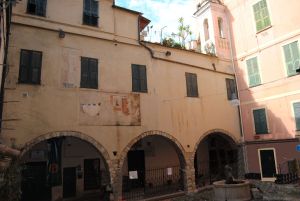 In the meantime, the old Praetorian Palace located in today's Piazza dei Dolori in the building complex that also included the Oratory of San Sebastiano had become inadequate for the increased administrative and bureaucratic needs of the community.
In the meantime, the old Praetorian Palace located in today's Piazza dei Dolori in the building complex that also included the Oratory of San Sebastiano had become inadequate for the increased administrative and bureaucratic needs of the community.
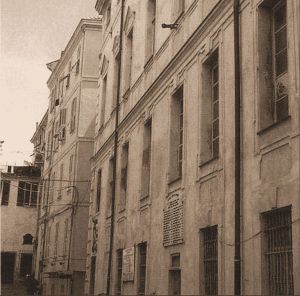 At the beginning of the 16th century, perhaps because of the difficulty of reaching the ancient Palazzo della Pigna, which was repaired out of respect for the authorities, the political and economic centre of the city had moved to Piazza Santo Stefano around the new Palazzo Comunale, which was enlarged and renovated to respond better to its role as the new seat of municipal administration.
At the beginning of the 16th century, perhaps because of the difficulty of reaching the ancient Palazzo della Pigna, which was repaired out of respect for the authorities, the political and economic centre of the city had moved to Piazza Santo Stefano around the new Palazzo Comunale, which was enlarged and renovated to respond better to its role as the new seat of municipal administration.
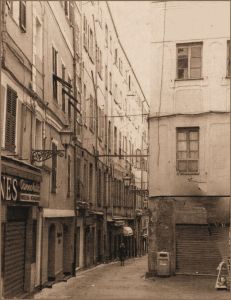 With subsequent resolutions of 4 and 11 October and 8 November 1532, the repair of the road leading from the Palazzo del Comune (also known as the Palazzo del Podestà) to the Ponte del Cavallo, located in the southern part of what is now Piazza Eroi Sanremesi, perhaps identifiable with the downhill stretch of today's Via Palazzo in the western part of its route, was also approved.
With subsequent resolutions of 4 and 11 October and 8 November 1532, the repair of the road leading from the Palazzo del Comune (also known as the Palazzo del Podestà) to the Ponte del Cavallo, located in the southern part of what is now Piazza Eroi Sanremesi, perhaps identifiable with the downhill stretch of today's Via Palazzo in the western part of its route, was also approved.
At the beginning of the 16th century, the western wing of the town hall was joined by an archivolt to a small building that served as the cavalerio (type of officer) of the podestà and faced a large vegetable plot, corresponding to the present Piazza Nota, owned by the Oratory of the Madonna della Costa.
After the city was elevated by the Genoese government to the position of General Commissioner of Arms in 1651, with powers of surveillance and jurisdiction over the entire territory between Noli and Ventimiglia, the municipal administration of Matuzia, which from then on had to provide for the accommodation expenses of the new official, with a consequent increase in the number of rooms needed to house the increased number of servants and employees, decided to undertake the construction of a large palace to meet the needs arising from the installation of the new administrative body in the city.
It was therefore decided to enlarge the small building for the employees of the podestà and his vicar, which stood to the west of the Porta del Quadrivio, situated at the junction of the Roman road with the one coming from the sea and heading towards La Pigna.
On 6 September 1666, the Municipal Council commissioned Agostino Faraldo and Giacomo Balestero to make careful enquiries about the owner of the kitchen garden located near the modest building where the vicar lived, and the price asked for its sale. On 22 June the following year, the two deputies told the Council that the purchase of the land would require an outlay of 250 lire.
Once the purchase of the garden at the proposed price had been decided, less than a month later the architect Pietro Antonio Corradi, who had already designed the project for the adjacent monastery of the Turchine, was commissioned to draw up the general design of the future residence of the Government Commissioner.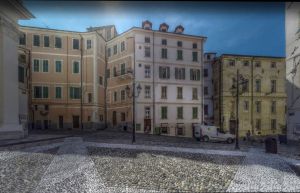 Having resolved a number of controversies arising from the uncertainty as to whether a fig tree that had grown in the area had been in the territory already belonging to the Municipality or in that which it was about to acquire from the Oratory of the Costa, at the beginning of September 1667 the Municipal Council awarded the contract for the construction of the large building.
Having resolved a number of controversies arising from the uncertainty as to whether a fig tree that had grown in the area had been in the territory already belonging to the Municipality or in that which it was about to acquire from the Oratory of the Costa, at the beginning of September 1667 the Municipal Council awarded the contract for the construction of the large building.
The specifications provided for the construction of the building in accordance with the detailed plan drawn up the previous April by the architect Gio Batta Martini, who had provided for the overall length of the palace to be extended by one palm in comparison with the length originally established by Corradi in his initial project of 1659.
The expenses for the construction of the building also included those for the doors, locks, windows, balconies, swallows and the like, except for the glass. Martini was paid with the sum of four silver scudi, while Corradi was rewarded with two barrels of oil. Two subsequent allocations of 8,000 and 2,000,500 lire, made respectively in August 1668 and 12 April 1669 and addressed to Martini, covered the costs of the palace, which had evidently risen. However, it seems that the cost of erecting the building totalled 13,000 lire, as shown by a deed dated 1670.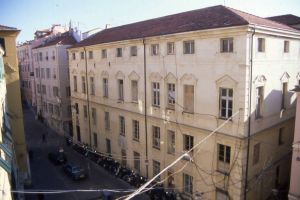 Work on the building began in September 1667 and was not finally completed until July 1680, under the direction of site manager Gio Batta Aicardo, who was replaced in 1678 by Maria Antonio Fornaro. In the course of this work, a project to extend and improve the structure was also presented, which was drawn up in 1671 by Martini himself, who had already designed the 1667 plan.
Work on the building began in September 1667 and was not finally completed until July 1680, under the direction of site manager Gio Batta Aicardo, who was replaced in 1678 by Maria Antonio Fornaro. In the course of this work, a project to extend and improve the structure was also presented, which was drawn up in 1671 by Martini himself, who had already designed the 1667 plan.
In 1676 the local authorities had in the meantime asked the Senate of the Republic for permission to have the Arms of the Community painted on the palace, for the construction of which another thousand liras were allocated in April and June 1678. However, it was not until 1687 that the newly completed palace became the official seat of the Commissioner General of the Republic.
Between 1757 and 1762, a number of interventions were carried out to completely renovate the building, which had been damaged by naval bombardments in 1678. The work, which led to the creation of 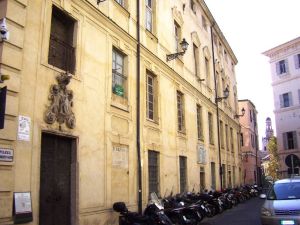 the piano nobile and a mezzanine floor, was directed in particular by Pietro Cantone, who was assisted by his brother-in-law Giuseppe Fontana and the painter and architect Francesco Carrega.
the piano nobile and a mezzanine floor, was directed in particular by Pietro Cantone, who was assisted by his brother-in-law Giuseppe Fontana and the painter and architect Francesco Carrega.
The renovation also included stucco decoration in relief of the outer walls in the style of the great Genoese palaces. The new arrangement of the façade in front of what is now Piazza Nota compared to that of the previous century led, among other things, to a considerable increase in the size of the building, a conspicuous enrichment in terms of decoration and greater attention to architectural details, with the aim of making the palazzo even more important and prestigious.
Facing Piazza Nota, the main façade of the building is arranged on two floors, in addition to the ground floor and mezzanine, and is marked by ten axes of windows, only the first seven of which are regularly spaced. The second floor, or main floor, which was built more recently, is characterised not only by large windows with elaborate gables and frames, but also by horizontal elements that protrude slightly from the body of the building, such as a cornice, a string course and a cornice.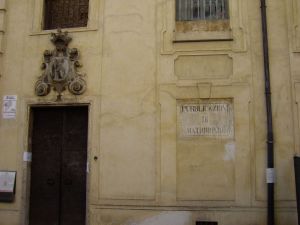
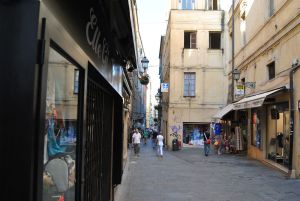 On the ground floor, the entrance door is surmounted by a marble frieze in relief depicting the city's emblem, created in 1713 by the Ticino stucco artist Gio Andrea Manni and placed in a lateral position with respect to the main axis of the building.
On the ground floor, the entrance door is surmounted by a marble frieze in relief depicting the city's emblem, created in 1713 by the Ticino stucco artist Gio Andrea Manni and placed in a lateral position with respect to the main axis of the building.
The façade facing Via Palazzo is also very different in that it is made up of the more massive body of the building and the protruding body, the so-called 'tooth', at whose level a loggia opens on the third floor, enlivened by four arches and five pilasters decorated with a capital.
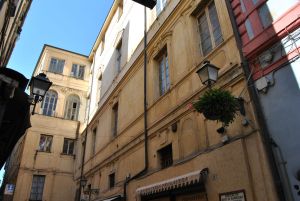 The rear façade, on the other hand, is punctuated by wall openings emphasised by cornices and gables in relief, the decoration of which differs slightly from that on the façade facing Piazza Nota.
The rear façade, on the other hand, is punctuated by wall openings emphasised by cornices and gables in relief, the decoration of which differs slightly from that on the façade facing Piazza Nota. 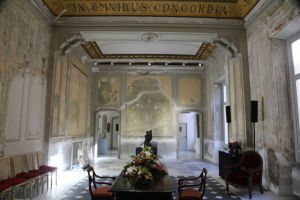 The main floor of the palace, which dates back to the 18th century, was intended to house the reception rooms and meeting rooms, all of which were covered by pavilion vaults.
The main floor of the palace, which dates back to the 18th century, was intended to house the reception rooms and meeting rooms, all of which were covered by pavilion vaults.
On the first floor of the palace, on the initiative of Governor Domenico Maria Doria, a chapel was also built, completed in 1722, where Mass was celebrated on feast days in the presence of the Commissioner General and other officials of the San Remo government office.
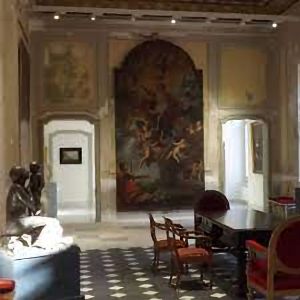 During the 19th century the palace, which was then the seat of the municipality, underwent some ornamental work at the behest of Mayor Carli, who financed it from the provisions of his office, while in August 1841 a general restructuring of the municipal offices was decided, which was then planned by the royal measurer Paolo Ammirati between January and February 1842.
During the 19th century the palace, which was then the seat of the municipality, underwent some ornamental work at the behest of Mayor Carli, who financed it from the provisions of his office, while in August 1841 a general restructuring of the municipal offices was decided, which was then planned by the royal measurer Paolo Ammirati between January and February 1842.
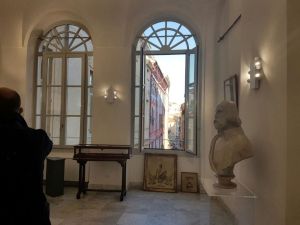 These works were followed by other minor interventions, including those carried out in 1840 by the decorator Giovanni Capoduro in the halls of the palace, which are said to have been previously frescoed by the Portoroese painter Maurizio Carrega.
These works were followed by other minor interventions, including those carried out in 1840 by the decorator Giovanni Capoduro in the halls of the palace, which are said to have been previously frescoed by the Portoroese painter Maurizio Carrega.
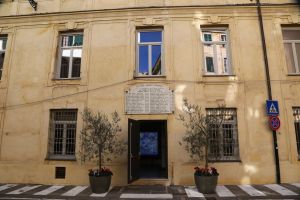
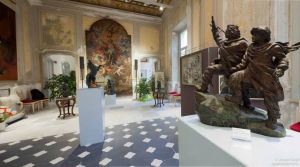 The palace, which remained the seat of the Municipality until the definitive transfer of the municipal offices to Palazzo Bellevue in 1968, has continued to be owned by the municipality and is now the seat of the Municipal Museum after its transfer from Palazzo Borea d'Olmo, as well as the seat of various associations and numerous public establishments on Via Palazzo.
The palace, which remained the seat of the Municipality until the definitive transfer of the municipal offices to Palazzo Bellevue in 1968, has continued to be owned by the municipality and is now the seat of the Municipal Museum after its transfer from Palazzo Borea d'Olmo, as well as the seat of various associations and numerous public establishments on Via Palazzo.
(Sources: for the text Andrea Gandolfo; Images from Private Archives and Web)




